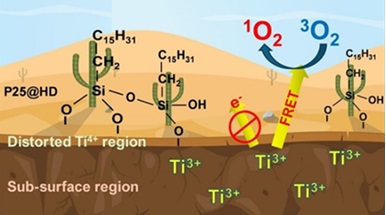
Titanium dioxide (TiO2) is widely used for its high refractive index and UV absorption properties, particularly in pigments and sunscreens. Surface silanization improves the dispersion of TiO2, its compatibility with various matrices, and reduces the formation of harmful reactive oxygen species (ROS). Despite its widespread use, significant questions remain regarding the photoinduced behavior of this material after silanization, particularly concerning the generation of singlet oxygen (1O2), an excited, highly reactive, and selective form of molecular oxygen. In this regard, the literature often remains inconclusive due to differing methodologies and indirect assessments.
Within this context, and in close collaboration with Prof. Francesco Parrino of the University of Trento, a research team comprising Pietro Mariani, Lorenzo Viganò, Francesca Cova, Irene Villa, and Massimiliano D’Arienzo from the Department of Materials Science at the University of Milano-Bicocca, recently published a ground-breaking study in the prestigious journal Angewandte Chemie [Wiley, Impact Factor 16.9, 2024 (Clarivate), https://onlinelibrary.wiley.com/doi/full/10.1002/anie.202414445] entitled “Singlet Oxygen Photocatalytic Generation by Silanized TiO2 Nanoparticles”.
The core innovation of this work lies in the generation of singlet oxygen through an energy transfer mechanism from stabilized electronic defects. Specifically, surface silanization of TiO2 induces changes in the coordination of surface titanium centres and stabilizes Ti3+ defects in the subsurface region. Under UV and near-infrared (NIR) irradiation, the energy absorbed by the nanoparticles is localized in these Ti3+ centres, which can then transfer this energy to molecular oxygen adsorbed on the surface, selectively promoting it to the singlet excited state. This process does not involve electron transfer but rather a Förster-type energy transfer (FRET), which is much more selective and less destructive than classical photocatalytic mechanisms.
To confirm the formation of 1O2, the authors proposed a model system based on the epoxidation of limonene, a terpene that is abundant and well known in organic chemistry. The highly selective reaction occurred only in the presence of light and the silanized catalyst, thus providing clear experimental evidence of the active role of singlet oxygen. This test not only reinforces the validity of the proposed mechanism but also demonstrates the practical application potential of this new class of photocatalysts in organic reactions of industrial and environmental relevance.
Finally, this work offers, on one hand, a new strategy to control TiO2 reactivity, steering it towards desired and selective products, and on the other hand, opens the way for further investigations aimed at clarifying potential safety issues related to the widespread use of silanized TiO2 in cosmetic and personal care products.